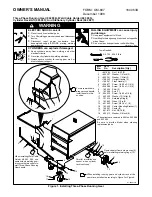
Sound x [A]
No Sound
Sound x [+N]
Sound x [A]
No Sound
Alarm
Flashing x [A]
No Flashing
Alarm Flashing x [+N]
Freq.
Up and down scale modulation
Time
Freq.
Multitone
Time
Freq.
Up-scale modulation
Time
Alarm
Flashing x [A]
Memory
Flashing x [A]
No Sound
12
12
[+N]
[A]
12
12
40 sec.
Max. A Time
Positiv pol.
SOUND
FLASHING
Tab. 2 - Graphic illustration: alarm priority
Tab. 3 - Frequency profile of the audible signals
AVAILABLE SOUNDS
REASON FOR ACTIVATION
TAMPER PROTECTION IN
AUTOMATIC MODE
[+N] with +N jumper connected
[+N] with +N jumper disconnected
[A] with S jumper connected
[A] with S jumper disconnected
CARRIER
FREQUENCY
1145 Hz
1149 Hz
-
1149 Hz
1120 Hz
SOUND LEVEL
at 3m-CALL-
105dB(A)
105dB(A)
105dB(A)
105dB(A)
105dB(A)
SOUND LEVEL
at 3m-LADY-
101dB(A)
101dB(A)
101dB(A)
101dB(A)
101dB(A)
TYPE OF SOUND
Up and scale modulation (LF)
Up and down scale modulation
(LF)
Up and down scale modulation
(HF)
Up and down scale modulation
(LF)
Modulation (HF)
[SP]
[+N]
[ ]
[A]
[G]
[AS]
[ASG]
- Magneto dynamic exponential horn connection terminals
- Voltage (positive) and alarm terminal. 13.8V should be applied to this terminal for the battery
charge. If this voltage fails (wire cutting or alarm) the SIREN will go into alarm status
- Negative supply terminal and ground of the internal circuit
- Alarm activation terminal with programmable polarity
- Trouble signal terminal for: low battery or battery trouble conditions; horn trouble; fasher
bulb damage (Strobe board NOT PRESENT), Normally closed to negative. This terminal
will open in the event of trouble.
- Tamper: these terminals will open when the cover or innerplate is removed. Or when
SIREN is pulled from the well (for normal mode ONLY)
TERMINALS DESCRIPTION
The Alarm Time will be counted from activation of the horn and strobe/flasher.
When the maximum Alarm Time of the higher priority Alarm expires, or when the Alarm conditions clear, the
lower Drioritv Alarm sianal will activate the horn and strobe/flasher in accordance with its configuration.
If a pdority Alarm signal overrides an Alarm that has been running for more than 30 seconds, the maximum
Alarm Time of the interrupted signal will
RUN ON
.
If the pdority Alarm terminates (due to Timeout or Restoral) before the maximum Alarm Time of the
interrupted signal expires, the latter will activate the horn and strobe/flasher for the residual time.
If a pdority Alarm signal overrides an Alarm that has been running for less than 30 seconds, the maximum
Alarm Time of the interrupted signal will
FREEZE
.
If the interrupted Alarm signal is still present when the priority Alarm terminates (due to Timeout or Restoral),
it will activate the horn and strobe/flasher in accordance with its configuration.
If the interrupted Alarm signal has restored when the priority Alarm terminates (due to Timeout or Restoral),
it will activate the horn and strobe/flasher for 30 seconds.
Table 2 shows how the lower pdority Alarm signal [A] will activate the horn and strobe/flasher after the
higher pdority Alarm (Alarm signal [+N]) has been executed.
Memory flashing will stop (after the maximum Alarm-Time) when all the signals, that triggered the Alarm,
restore to standby for 5 seconds (Restoral Time). Internal Tamper Restoral requires 40 seconds.
PROGRAMMING
The board Jumpers (Wire and Link) are already connected (see fig. 2).
If you are installing several SIRENS Hornstrobes in the same area, the Jumper Wires will allow you to select
a different sound for each one, thus permitting Users to distinguish between them.
You can also select different sounds for different Alarm types (gas leak, burglary, flooding, etc.) Or locations
(office, warehouse, garage, etc.)
This feature will allow users to recognize the Alarm type and its location.
The wire Jumpers (+N and S) will allow you to select the sounds for Inputs [+N] and [A], respectively. These
Jumpers will also allow you to set the maximum Alarm Time for Internal tamper.
For the various programming options provides by the Wire and Link Jumpers refer to Table 2.
For the frequency profile of the audible signals refer to Table 3.
INSTALLATION
This SIREN should be mounted as high up as possible on a flat wall, as uneven surfaces may jeopardize
proper functioning of the Snatch protection.
1. Using the Drilling pattern, mark the screw location (5 and 12) then ddll the anchor screw holes.
NOTE:
The screw locations on the pattern correspond to the anchor screw holes on the backplate.
2. Pull the wires through the cable entry (16).
3. Secure the backplate and Snatch device to the wall.
WARNING:
Do not over tighten the snatch bracket screw (12) as this may damage the bracket wings (see
figure 1 ).
4. Complete the connections on the terminal board (10) as per the instruction in the relevant paragraph.
5. Mount the battery on its support (6) and complete the battery connections (see figure 1).
At this point the flasher/strobe will flash, as per Memory flashing (Installation phase).
This status wilt be held until internal Tamper ends (i.e. until the Metal Innerplate and Cover are secured).
Once terminated, a 20 second Startup phase will begin (signalled by fast flashing).
If internal tamper occurs during this phase this SIREN will go back to the installation phase.
If 13.8 V is applied to terminal [+N], after the Startup phase, this SIREN will be operative.
Otherwise, it will enter the Wait phase, which will be held until 13.8 V is applied to terminal [+N], or until
Internal Tamper occurs.
In the latter case this SIREN will go back to the installation phase.
Once the Wait phase terminates, the 20 second Startup phase will begin, after which, installation will be
complete.
If Internal Tamper occurs during the Startup phase, this SIREN will go back to the Installation phase,
however, if the 13.8 V fails on terminal [+N] this SIREN will go back to the Wait phase.






















